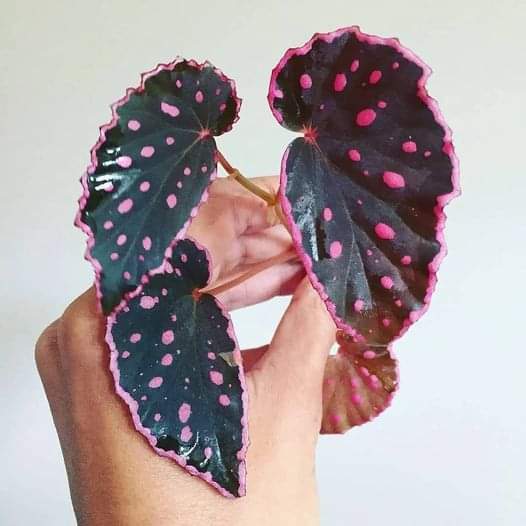
Description
Begonia is a genus of about 1,300 species of annuals, perennials, shrubs and climbers. They are characterized by their fleshy stems and are mostly grown for their showy flowers or colorful leaves. They are generally easy to grow plants that will add interest to your garden throughout the growing season.
Begonia TypesBegonias can be categorized in several ways. Here are some of the most common groups of begonias:
Wax Begonias (Semperflorens)
Also known as fibrous begonias, they are the most prolific bloomers of the begonia family. This group of begonias features a fibrous root. These begonias are prized for their tight mounds of waxy leaves and bright colored petite blossoms.
Wax begonias, typically grown as annuals, are usually sold in market packs and used as bedding plants because they proliferate, are low maintenance, and offer plenty of color for most of the growing season. They’re also great in containers and hanging baskets, where they bloom in scarlet, pink, yellow, apricot, salmon and rose.
The Basics
Bloom ᴛι̇ɱe: Spring through fallLight Needs: Part-shade to full sunHardiness Zones: 9 to 11Cane Begonias (Angel Wing Begonias)
This group of begonias is commonly referred to as angel wing begonia. They are evergreen, perennial plants with an upright growing habit. Cane begonias have woody stems with bamboo-like joints. They are grown for their impressive form as well as attractive leaves and flowers. Angel wing begonias are popular houseplants.
How To Grow BegoniasThe best way to ensure the survival of any begonia houseplant is to select the proper location indoors that matches their lighting needs.
Rhizomatous and fibrous-rooted species like Rex begonias are often grown as houseplants. While you can grow tuberous begonias indoors, they are harder to take care of due to their light and humidity needs.
Like most houseplants, begonias prefer bright, indirect light and plenty of humidity. If the air in your home is dry, especially in the winter, set the begonia houseplants on a shallow tray filled with pebbles and water, but keep the water level below the pebbles to prevent water from wicking into the pot through capillary action. Or, invest in a small humidifier.
While begonias enjoy a humid environment, that doesn’t mean that they need frequent watering. Allow the top inch or so of potting soil to dry out before giving your potted begonia a good drink. It’s a good idea to water until it runs out of the bottom of the pot to make sure that the soil is completely saturated.
Also, begonias love company. Aɱaпda Spangler, a horticulturist and lecturer for the University of Tennessee’s Department of Plant Sciences, suggests grouping a few of your favorite houseplants together to create a microclimate of increased humidity in the area around your begonia plants.
In cold regions, wintering hardy tuberous begonias inside is an excellent way to keep them from year to year. These types perform best in a brightly lit room, but indoor humidity is drier than these plants prefer.
How to Care for BegoniasBegonias are generally not difficult to grow or maintain, but it’s important to know what type you have so you can care for it properly. In general, begonias like indirect sunlight or shade, regular watering, and well-drained soil that is rich in organic matter. They need regular deadheading to clear away spent flowers.
LightTuberous begonias in containers need a bit of sun but partial sun is fine. Indoors, begonias do best in indirect light. Fibrous or wax begonias planted in the garden will flower consistently in shade or partial shade. Too much bright sun might wilt the delicate petals or cause the colors to fade.
SoilBegonias enjoy a porous, rich soil that is slightly acidic. Peat-based soils with plenty of organic matter including leaf mold are good for begonias. Good drainage is essential. A basic potting mix such as that used for African violets will also suffice.
WaterWater your begonia thoroughly about once a week, and wait until the top half inch of the soil is dry before watering. It’s very important to avoid overwatering begonias, as this can lead to root rot.
Temperature and HumidityBegonias grown indoors grow best with a consistent temperature range of 65 to 70 degrees Fahrenheit. Fibrous begonias planted in the garden should be all right with cool late summer evenings, but will begin to go dorɱaпt once the nights and days turn colder. Being a tropical plant, begonias like some humidity (just under 50%). In houses that tend to have dry air from winter heat, placing a saucer of water near your begonia, or using a humidifier in the room, can help the plant stay healthy and hydrated.
FertilizerFertilizer needs can vary slightly depending on the cultivar of your begonia. For rhizomatous begonias grown indoors, a basic water-soluble fertilizer mixed to quarter or half strength, applied to moistened soil in spring, will help promote blooms. Tuberous begonias are somewhat more hearty feeders, and like a 5-1-1 fertilizer (such as fish emulsion) applied twice a month during the blooming season. For hardy begonias, mix a bit of diluted fertilizer with some compost or peat moss and apply sparingly (too much fertilizer may harm the leaves).